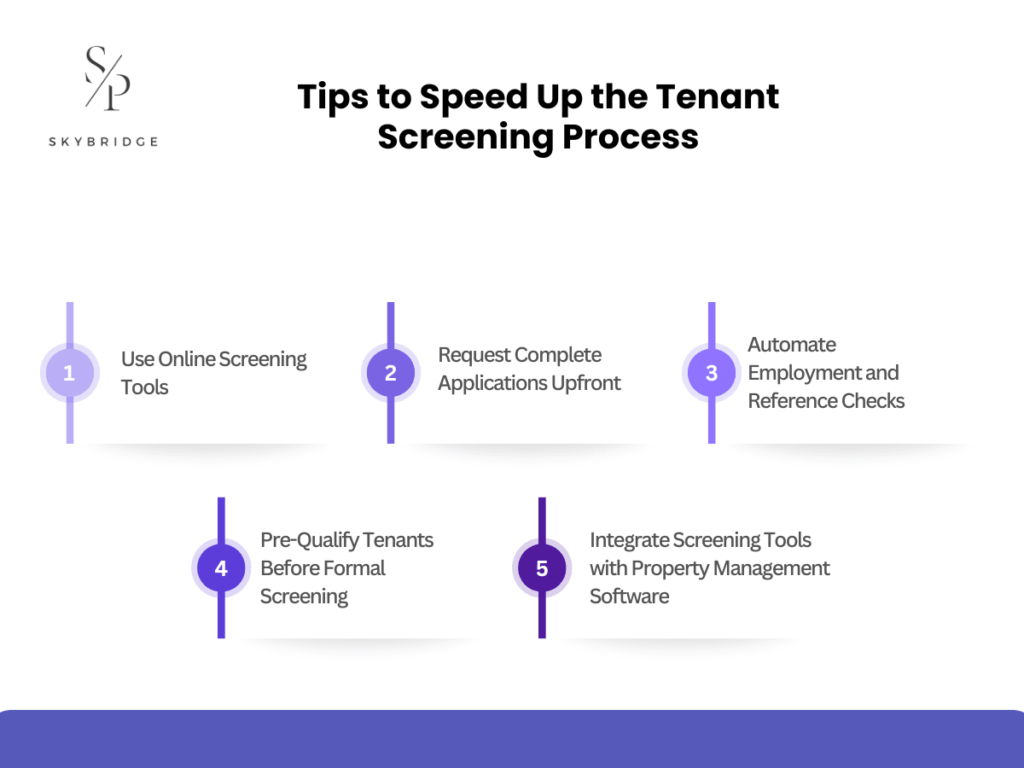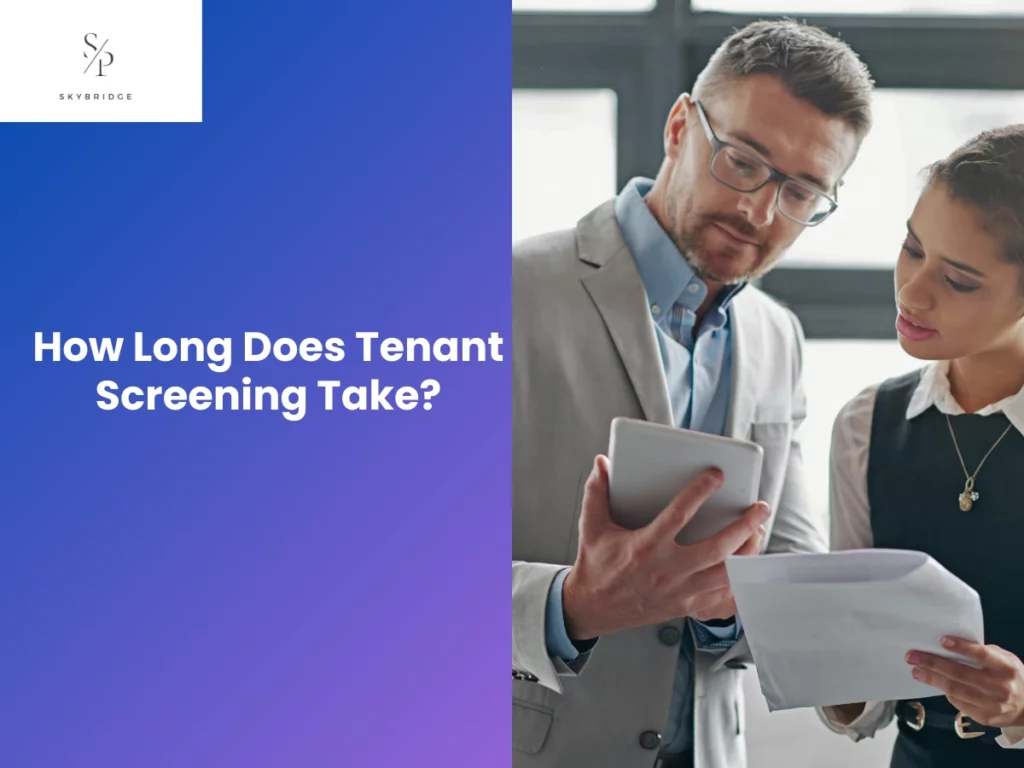Tenant screening usually takes 24 to 72 hours. The timeline depends on factors like credit checks, employment verification, rental history, background checks, and how quickly references respond.
While a credit check can be completed almost instantly through automated platforms, other steps are less predictable. Employment verification and reference checks often require manual outreach to past landlords or employers, and delays in responses can add two to three extra days. These manual verification delays are the most common reason screenings take longer.
Because timing varies across each step, the method of tenant screening makes a big difference. Manual reviews may take several days, third-party services often return results in 24–48 hours, and automated platforms can deliver reports in minutes. By using online screening tools like RentSpree or integrated systems such as AppFolio, landlords can automate verifications and reduce overall processing time to the 24-hour range.
What Factors Delay the Tenant Screening Process?

Tenant screening is often delayed by incomplete applications, slow employer or landlord responses, manual verification processes, and mismatched information. Missing documents, unreturned calls, or data errors typically force manual follow-ups, adding extra days to the process. These issues make it important for landlords to use clear application requirements and reliable screening tools to keep timelines on track.
Incomplete Applications
Applications missing proof of income, rental history, employer details, or government ID are the leading cause of screening delays. Without these essentials, landlords must chase applicants for updates, and the process stalls until all documents are provided. Even minor omissions, such as a missing phone number, often trigger manual follow-ups that add extra days. To keep timelines short, landlords should require complete applications up front and give tenants a checklist of mandatory items before generating a tenant screening report.
Slow Employer or Landlord Response
Tenant screening often slows when employers or previous landlords take too long to return calls or emails. Employment verification may require HR confirmation, which is not always immediate, and landlord references may be difficult to reach if their contact details are outdated. Each delay in communication can add two to three days to the process. Because these responses are outside a landlord’s control, they remain one of the most common and frustrating screening bottlenecks.
Manual Verification Processes
When tenant screening relies on manual methods like phone calls, faxed forms, or emailed document requests, the process almost always takes longer. Each employment or rental history check requires a human response, and even one unanswered call can push the timeline back by several days. Unlike automated systems that connect directly with credit and background databases, manual methods depend on availability and follow-through, making them especially slow during busy rental seasons or when handling multiple applications.
High Volume of Applications
Tenant screening delays often occur when property managers must process dozens of rental applications at once, especially during peak leasing seasons. Each file requires credit checks, employment verification, and reference follow-ups, creating bottlenecks when staff or systems are overloaded. Even small slowdowns multiply across multiple applicants, stretching timelines by several days. High application volume is one of the main reasons larger landlords and management companies adopt automated screening platforms to keep processing times manageable.
Incorrect or Mismatched Information
Errors in an application, such as misspelled names, outdated addresses, or incorrect Social Security numbers, can bring tenant screening to a halt. These mismatches typically trigger manual reviews, requiring property managers or screening services to confirm details before moving forward. Even small mistakes can mean re-checking records with credit bureaus or background databases, which may add several days. Clear instructions and ID verification upfront help reduce these common but avoidable delays in producing a tenant screening report.
Outdated or Inaccessible References
Tenant screening slows down when listed references cannot be reached or provide outdated contact information. Old phone numbers, inactive email addresses, or unresponsive landlords force property managers to track down alternate contacts, adding days to the process. Since employment and rental history checks rely on accurate references, even a single unreachable contact can stall a tenant screening report. Landlords can minimize these delays by requiring applicants to provide current details and at least two reliable references.
Delayed Credit Bureau Reports
Credit checks are usually fast, but delays happen when credit bureaus experience system backlogs, technical issues, or queued report requests. Most automated pulls return within minutes, yet high demand or outages can stretch results by one to two days. Since credit and background checks are central to screening, even short slowdowns stall the process. Landlords can reduce this risk by using platforms like TransUnion SmartMove or RentSpree, which integrate directly with multiple bureaus to reduce the risk of slowdowns.
Background Check Complexities
Background checks can take longer when applicants have multiple past addresses, aliases, or records across different states. Each record must be verified individually, and cross-jurisdiction searches often extend the process by two to three days. Applicants with criminal, eviction, or court records also require deeper reviews, adding further time. To manage these cases more efficiently, property managers often use screening platforms that combine national, state, and county databases, which helps reduce delays and deliver more complete background checks.
Technical System Failures or Portal Downtime
Unexpected system outages, integration errors, or platform downtime can bring tenant screening to a standstill. When credit or background checks cannot be submitted, landlords must wait for the system to recover before results are processed. Even brief downtime can add one to two days, while extended issues during peak rental seasons may cause longer delays. To avoid these setbacks, many property managers rely on well-established platforms with high uptime guarantees, ensuring smoother workflows and fewer technical disruptions.
Fraud Flags or Suspicious Patterns
Tenant screening slows significantly when applications trigger fraud alerts such as mismatched IDs, falsified pay stubs, or unusual income patterns. These red flags require manual review and, in some cases, secondary verification with employers or financial institutions. Investigating suspicious information can add several days to the timeline, especially if additional documents are requested. To reduce risks, landlords often use fraud-detection tools built into platforms like Snappt or TransUnion SmartMove, which catch inconsistencies earlier in the process.
How Long Do Credit Checks Take in Tenant Screening?
Credit checks typically take just minutes when run through automated platforms, while manual requests or bureau verification issues can extend the process to 24–48 hours. Most landlords rely on soft (instant) pulls for speed, but mismatched data or hard (manual) checks may require extra review, adding up to a day or two for the final tenant screening report.
Instant vs Manual Credit Checks
Instant credit checks, often built into online screening platforms, return results within minutes by pulling data directly from credit bureaus. Manual credit checks, on the other hand, may involve faxed or emailed requests, staff review, and extra verification steps, which can take 24–48 hours. While instant checks are faster and convenient, manual checks are still used by some smaller landlords who prefer more control or need to resolve data mismatches.
Bureau Report Timeframes
Credit bureaus such as Experian, Equifax, and TransUnion usually return reports within minutes when accessed through automated systems. In some cases, high request volumes or mismatched applicant data can slow responses, extending the process to 24–48 hours. The exact timeframe depends on whether the request is a soft pull, often used in tenant screening for speed, or a hard pull, which may take longer and require additional verification.
Delays Due to Verification Mismatches
Verification mismatches, such as incorrect Social Security numbers, name variations, or outdated employment records, can slow credit checks by one to two days. These errors trigger manual reviews, requiring property managers or bureaus to confirm details before releasing a tenant screening report. Even minor inconsistencies often cause re-checks, making mismatches one of the most common reasons credit reports are delayed during tenant screening.
Tips to Speed Up the Tenant Screening Process

The fastest ways to shorten tenant screening are to collect fully completed applications, use online screening platforms, and automate employment or reference checks. These steps prevent common delays, reduce manual follow-ups, and allow landlords to receive a complete tenant screening report much sooner.
Use Online Screening Tools
Online screening tools like RentSpree, SmartMove, or AppFolio provide instant access to credit and background checks, cutting processing time from days to minutes. These platforms automate verification, flag errors early, and often include built-in fraud detection. By reducing manual work and back-and-forth communication, landlords can process applications more efficiently and keep the overall tenant screening timeline closer to 24 hours.
Request Complete Applications Upfront
Requiring applicants to submit all documents at the start, such as ID, proof of income, and landlord contact details, helps prevent delays. Incomplete applications often force manual follow-ups, adding days to the process. By setting clear requirements and using a checklist, landlords ensure applications are ready for immediate credit and background checks, keeping tenant screening efficient and on schedule.
Automate Employment and Reference Checks
Manual employment and rental history checks are some of the slowest parts of tenant screening. Platforms like AppFolio, Buildium, or RentSpree automate this step by sending verification requests instantly, tracking responses, and flagging missing details in real time. This reduces repeated follow-ups and human error, cutting delays by one to two days and keeping most tenant screening reports within the typical 24–72 hour timeframe.
Pre-Qualify Tenants Before Formal Screening
Delays can be avoided by screening out unqualified applicants early with clear pre-qualification criteria. Setting income minimums, acceptable credit score ranges, and rental history requirements helps landlords focus only on serious candidates. This step reduces unnecessary applications, lowers manual workload, and ensures the full tenant screening report is reserved for renters most likely to be approved.
Integrate Screening Tools with Property Management Software
Tenant screening moves faster when tools like TransUnion SmartMove, RentSpree, or Experian Connect are built directly into property management platforms such as AppFolio or Buildium. This integration enables credit, background, and eviction checks to run automatically while applicant data syncs in real time. By removing duplicate entries and manual uploads, landlords shorten turnaround times and keep most tenant screenings within a 48-hour window.
Different Types of Tenant Screening Methods and Their Timelines
Tenant screening can take 2–3 days with manual reviews, 24–48 hours with third-party services, or just minutes with fully automated platforms. Manual checks depend on phone calls and paperwork, third-party providers blend automation with human oversight, and automated tools like RentSpree or SmartMove deliver near-instant credit and background reports.
Traditional Manual Screening
Traditional tenant screening relies on non-digital methods such as phone calls, mailed or faxed forms, and paper records. Landlords manually contact employers and previous landlords to verify income and rental history, often waiting days for responses. This process flow is slow and prone to missed calls or delayed paperwork. On average, manual screening takes 2–3 business days, and in busy rental periods, it may stretch even longer before a tenant screening report is completed.
Third-Party Screening Services
Many landlords choose third-party screening services to handle the heavy lifting of credit reports, background checks, and eviction history. These providers mix automation with manual review, which speeds up the process compared to traditional methods. Typical turnaround is 24–48 hours, though timing can vary if references are slow to respond. Well-known options like TransUnion SmartMove or RentSpree are commonly used in property management to deliver a comprehensive tenant screening report.
Fully Automated Screening Platforms
With fully automated screening platforms, landlords can access credit, background, and eviction reports almost instantly. These tools pull data directly from credit bureaus and national databases, cutting out manual steps and reducing the chance of delays. Reports are typically ready within minutes, making this the fastest option for generating a tenant screening report. Common examples include RentSpree, Experian Connect, and SmartMove, which streamline the entire process into a single digital workflow.
How Property Management Companies Accelerate Tenant Screening?
A property management company accelerates tenant screening by using digital tools, trained staff, and standardized processes that reduce delays. These companies rely on platforms like AppFolio, Buildium, or RentSpree to run instant credit, background, and eviction checks while automating employment and reference verifications. By delegating this work to a property management company, landlords save time, avoid manual errors, and ensure a complete tenant screening report is delivered quickly and in compliance with regulations.







